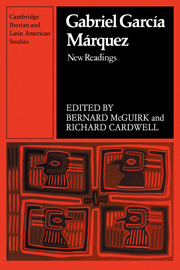Book contents
- Frontmatter
- Contents
- Note on the translations
- List of contributors
- Introduction
- 1 Characterization in the early fiction of Gabriel García Márquez
- 2 Beware of gift-bearing tales: reading ‘Baltazar's Prodigious Afternoon’ according to Marcel Mauss
- 3 The body as political instrument: communication in No One Writes to the Colonel
- 4 Magical realism and the theme of incest in One Hundred Years of Solitude
- 5 Translation and genealogy: One Hundred Years of Solitude
- 6 The humour of One Hundred Years of Solitude
- 7 On ‘magical’ and social realism in García Márquez
- 8 Aspects of narrative structure in The Incredible and Sad Story of the Innocent Eréndira and her Heartless Grandmother
- 9 Language and power in The Autumn of the Patriarch
- 10 Writing and ritual in Chronicle of a Death Foretold
- 11 Free-play of fore-play: the fiction of non-consummation: speculations on Chronicle of a Death Foretold
- 12 A prospective post-script : apropos of Love in the Times of Cholera
- The solitude of Latin America: Nobel address 1982
- Select bibliography
- Index
10 - Writing and ritual in Chronicle of a Death Foretold
Published online by Cambridge University Press: 05 November 2011
- Frontmatter
- Contents
- Note on the translations
- List of contributors
- Introduction
- 1 Characterization in the early fiction of Gabriel García Márquez
- 2 Beware of gift-bearing tales: reading ‘Baltazar's Prodigious Afternoon’ according to Marcel Mauss
- 3 The body as political instrument: communication in No One Writes to the Colonel
- 4 Magical realism and the theme of incest in One Hundred Years of Solitude
- 5 Translation and genealogy: One Hundred Years of Solitude
- 6 The humour of One Hundred Years of Solitude
- 7 On ‘magical’ and social realism in García Márquez
- 8 Aspects of narrative structure in The Incredible and Sad Story of the Innocent Eréndira and her Heartless Grandmother
- 9 Language and power in The Autumn of the Patriarch
- 10 Writing and ritual in Chronicle of a Death Foretold
- 11 Free-play of fore-play: the fiction of non-consummation: speculations on Chronicle of a Death Foretold
- 12 A prospective post-script : apropos of Love in the Times of Cholera
- The solitude of Latin America: Nobel address 1982
- Select bibliography
- Index
Summary
Gloomy Orion and the Dog
Are veiled; and hushed the shrunken seas.
(T. S. Eliot, ‘Sweeney Among the Nightingales’)If one were to take to the letter Chronicle of a Death Foretold's avowed generic filiation as reportage, one would have to acknowledge immediately that the narrator's performance in its entirety constitutes nothing short of a scandal. For, as is made evident through the novel, the investigator was a member of the community in which the events took place, a circumstance that puts in check the objectivity that his rhetorical posturing demands. Even if the narrator takes pains to establish early on that he was asleep when tragedy struck, his ‘participation’ is implicitly recognized in the text when he himself refers to Santiago Nasar's death as a crime ‘for which we all could have been to blame’. As if to underscore this fact, the novel is quite careful in establishing the complex web of relationships that tied the narrator to all the protagonists of the tragic plot. In addition, the narrator time and again expresses his agreement with a given witness's opinion in a formula that arises from shared communal experience. ‘“One night he asked me which house I liked the most”, Angela Vicario told me. “And I answered, without knowing what he intended, that the prettiest house in town was the farmhouse belonging to the widower Xius.” I would have said the same' (p. 49, my italics).
- Type
- Chapter
- Information
- Gabriel García MárquezNew Readings, pp. 151 - 168Publisher: Cambridge University PressPrint publication year: 1987
- 4
- Cited by



